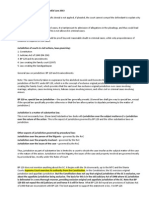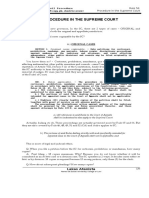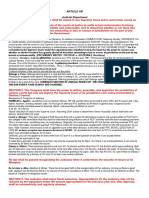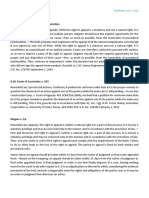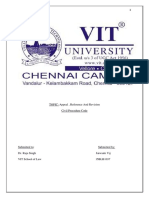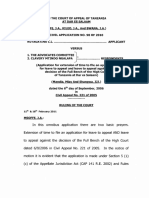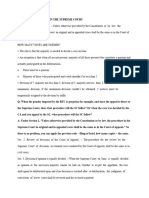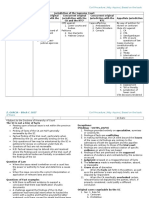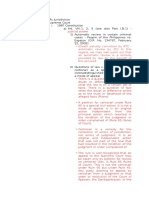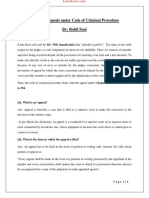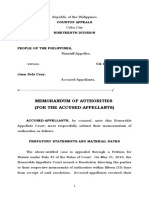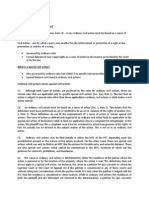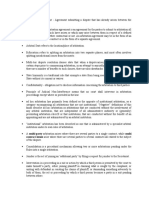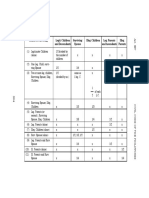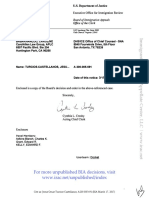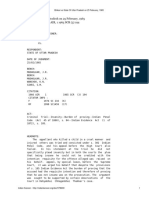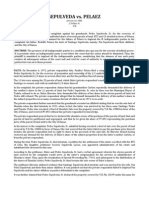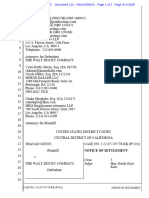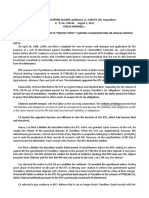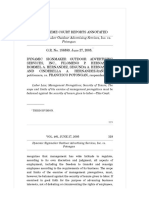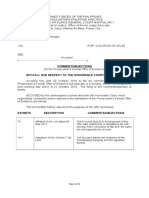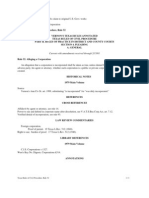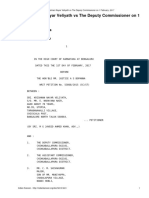Procedure in The Supreme Court: 1997 Rules On Civil Procedure 2001 Edition
Procedure in The Supreme Court: 1997 Rules On Civil Procedure 2001 Edition
Uploaded by
Manny DerainCopyright:
Available Formats
Procedure in The Supreme Court: 1997 Rules On Civil Procedure 2001 Edition
Procedure in The Supreme Court: 1997 Rules On Civil Procedure 2001 Edition
Uploaded by
Manny DerainOriginal Description:
Original Title
Copyright
Available Formats
Share this document
Did you find this document useful?
Is this content inappropriate?
Copyright:
Available Formats
Procedure in The Supreme Court: 1997 Rules On Civil Procedure 2001 Edition
Procedure in The Supreme Court: 1997 Rules On Civil Procedure 2001 Edition
Uploaded by
Manny DerainCopyright:
Available Formats
1997 Rules on Civil Procedure Rule 56
2001 Edition <draft copy. pls. check for errors> Procedure in the Supreme Court
Rule 56
PROCEDURE IN THE SUPREME COURT
This is an entirely new provision. In the SC, there are 2 types of cases – ORIGINAL and
APPEALED. The SC has both the original and appellate jurisdiction.
What are the original cases cognizable by the SC?
A.) ORIGINAL CASES
SECTION 1. Original cases cognizable. – Only petitions for certiorari,
prohibition, mandamus, quo warranto, habeas corpus, disciplinary proceedings
against members of the judiciary and attorneys, and cases affecting
ambassadors, other public ministers and consuls may be filed originally in
the Supreme Court. (n)
You know them no? – Certiorari, prohibition, mandamus, quo warranto, habeas corpus, cases
affecting ambassadors other public ministers and consuls – nasa Constitution din yan. This is only a
repetition of Article VIII, Section 5 (1) of the Constitution. Aside from that, the Rules of Court give
the SC authority to hear disciplinary proceedings against members of the judiciary, disbarment or
removal of judges. SC man yan ba! And they are governed specially for disbarment by Rule 139-B
of the Rules of Court.
SEC. 2. Rules applicable. – The procedure in original cases for
certiorari, prohibition, mandamus, quo warranto and habeas corpus shall be
in accordance with the applicable provisions of the Constitution, laws, and
Rules 46,48, 49, 51, 52 and this Rule, subject to the following provisions:
a.) All references in said Rules to the Court of Appeals shall be
understood to also apply to the Supreme Court;
b.) The portions of said Rules dealing strictly with and specifically
intended for appealed cases in the Court of Appeals shall not be applicable;
and
c.) Eighteen (18) clearly legible copies of the petition shall be filed,
together with proof of service on all adverse parties.
The proceedings for disciplinary action against members of the judiciary
shall be governed by the laws and Rules prescribed therefor, and those
against attorneys by Rule 139-B, as amended. (n)
a.) All references in said Rules to the Court of Appeals
shall be understood to also apply to the Supreme Court
Actually, kulang ito eh. These proceedings are actually governed more by Rule 65 and 66. But
they are also covered by Rule 46, 48, 49, 51 and 52 (CA) and it also applies to SC.
b.) The portions of said Rules dealing strictly with and specifically intended for
appealed cases in the Court of Appeals shall not be applicable; and
This is more of legal and judicial ethics.
Q: When you file a petition before the SC for certiorari, prohibition or mandamus, how many
copies?
A: First filing – 18 copies minimum. Why? Because you do not know whether it will be
considered as an en banc case or a division case. The SC operates in 2 ways. It decides cases either en
banc or by division. 18 copies is required because 15 na ang justices, only three (3) for the clerk.
Q: How about subsequent pleadings? How many copies?
Lakas Atenista 136
Ateneo de Davao University College of Law
1997 Rules on Civil Procedure Rule 56
2001 Edition <draft copy. pls. check for errors> Procedure in the Supreme Court
A: Depende. Kung en banc, all subsequent pleadings, still 18 copies. Kapag division case, 9 na
lang. Now, there are three divisions in the SC – the first, second and third divisions. And every
division is composed of five (5) members.
The SC meets en banc twice a week – Tuesday and Thursday – unless they have changed it. It is
called an en banc session. Cases are raffled for assignment by division. Monday and Wednesday,
hiwa-hiwalay sila – the 5 justices who belong to the same division meet together and discuss cases
which are raffled to that division. Friday is a NO SESSION but a working day. That is when they
study, prepare their decisions and resolutions. That is why we can also predict when will the result
of the Bar be released because that is an en banc session. Only the SC en banc can order the release of
the results of the Bar Exam. They have to pass a resolution.
B. APPEALED CASES
SEC. 3. Mode of appeal. – An appeal to the Supreme Court may be taken
only by a petition for review on certiorari, except in criminal cases where
the penalty imposed is death, reclusion perpetua or life imprisonment. (n)
There is only one way of appeal to the SC. The only mode of appeal recognized is Petition for
Review by Certiorari under Rule 45, except in criminal cases when the penalty imposed by the RTC
is death penalty, reclusion perpatua or life imprisonment where only ordinary appeal (under Rule 41)
is required. Outside of that, the only mode of appeal to the SC is Petition for Review by Certiorari.
Please connect this with Rule 45, Section 9:
Rule 45, Sec. 9. Rule applicable to both civil and criminal cases.- The
mode of appeal prescribed in this rule shall be applicable to both civil and
criminal cases except in criminal cases where the penalty imposed is death,
reclusion; perpetua or life imprisonment.
Rule 56, Sec. 4. Procedure.- The appeal shall be governed by and disposed
of in accordance with the applicable provisions of the Constitution, laws,
Rules 45, 48, sections l,2, and 5 to 11 of Rule 51, 52 and this rule.
Q: What are the grounds for dismissal of an appeal before the SC?
A: Section 5:
Section 5. Grounds for dismissal of appeal.- The appeal may be dismissed
motu propio or on motion of the respondent on the following grounds:
a. Failure to take the appeal within the reglementary period;
b. Lack of merit in the petition;
c. Failure to pay the requisite docket fee and other lawful fees or to
make a deposit for costs;
d. Failure to comply with the requirements regarding [proof of service
and contents of and the documents which should accompany the petition;
e. Failure to comply with any circular, directive or order of the Supreme
Court without justifiable cause;
f. Error in the choice of mode of appeal; and
g. The fact that the case is not appealable to the Supreme Court.
Connect Rule 56, Section 5 with Rule 45, Section 5. The grounds are identical, to wit:
Rule 45, Sec. 5. Dismissal or denial of petition. The failure of the
petitioner to comply with any of the foregoing requirement regarding the
payment of the docket and other lawful fees, deposit for costs, proof of
service of the petition, and the contents of and the documents which should
accompany the petition shall be sufficient ground for the dismissal thereof.
The Supreme Court may on its own initiative deny the petition on the
ground that the appeal is without merit, or is prosecuted manifestly for
delay or that the questions raised therein are too unsubstantial to require
consideration.
Sec. 6. Disposition of improper appeal – Except as provided in section 3,
Rule 122 regarding appeals in criminal cases where the penalty imposed is
Lakas Atenista 137
Ateneo de Davao University College of Law
1997 Rules on Civil Procedure Rule 56
2001 Edition <draft copy. pls. check for errors> Procedure in the Supreme Court
death, reclusion perpetua or life imprisonment, an appeal taken to the
Supreme Court by notice of appeal; shall be dismissed.
An appeal by certiorari taken to the Supreme court from the Regional
Trial Court submitting issues of fact may be referred to the Court of
Appeals for decision or appropriate action. The determination of the Supreme
Court on whether or not the issues of fact are involved shall be final.
This is already discussed in Rule 50, Section 2. A wrong appeal is a ground for a dismissal of
such appeal.
Q: If the appeal is on pure question of law (it should be before the SC) and by mistake the party
appealed to the CA, what will happen?
A: The appeal will be dismissed under Rule 50. The CA will not endorse the case to the SC.
Q: Suppose you will appeal by certiorari to the SC under Rule 45. Tapos, halo pala – hindi
naman pala question of law lahat – may kasamang question of fact. What will happen now in the
appeal?
A: Under Rule 56, Section 6, the SC may or may not dismiss the appeal. It may refer the matter
to the CA – baliktad noh? So it is not the same as Rule 50, Section 2.
Section 7. Procedure if opinion is divided. Where the court en banc is
equally divided in opinion, or the necessary majority cannot be had, the
case shall again be deliberated on, and if after such deliberation no
decision is reached, the original action commenced in the court shall be
dismissed; in appealed cases, the judgment or order appealed from shall
stand affirmed; and on all incidental matters, the petition or motion shall
be denied.
What happens if the justices of the SC are equally divided?
For instance, there were 4 in attendance in a division dahil absent ang isa – the result is 2:2. So,
we will deliberate again, but still 2:2. If that is so, the decision appealed from is considered
affirmed. In other words, the ruling in the lower court is considered correct.
The counterpart of this rule in Criminal Procedure is Rule 125, Section 3. If after deliberation,
the justices are even, they will deliberate again but still even. The decision must be acquittal. Since
you cannot break the tie, it must be in favor of the accused.
EN BANC CASES
Now, before we leave this topic, of course we know very well that when you appeal to the SC,
there are two possibilities – either it will be heard by a division (there are 3 divisions there) or your
case might be decided by the entire SC en banc.
Q: What cases are heard by the SC en banc?
A: There was a circular in 1993 issued by the SC enumerating en banc cases:
1.) Cases in which the constitutionality or validity of any treaty, international or executive
agreement, law, executive order, presidential decree, proclamation, order, instruction,
ordinance or regulations in question. For example, the recent Oil Deregulation Law;
2.) Criminal cases in which the appealed decision imposes death penalty; Criminal cases where
a change of venue is required to avoid miscarriage of justice where SC has to make an
order to change the venue;
Pag reclusion perpetua, hindi man yan en banc ba! Only for death penalty.
3.) Cases raising novel questions of law;
There is a point of law where there is no decided case yet. Meaning, such legal issue is
raised for the first time.
Lakas Atenista 138
Ateneo de Davao University College of Law
1997 Rules on Civil Procedure Rule 56
2001 Edition <draft copy. pls. check for errors> Procedure in the Supreme Court
4.) Cases affecting ambassadors, other public ministers or consuls;
5.) Cases involving decisions, resolutions, orders of the COMELEC, COA, or the Office of the
OMBUDSMAN, SANDIGANBAYAN in administrative disciplinary cases;
6.) Cases in which the penalty involved is a dismissal of the judge, officer or employee of the
judiciary, disbarment of a lawyer or even suspension of any of them for a period of more
than one (1) year of fine exceeding P10,000.
Tignan mo sa SCRA. Pag ang penalty is removal of a judge or disbarment, en banc yan.
And sometimes, you cannot even identify who is the ponente. Ang tawag diyan per
curiae. The ponente is not identified.
7.) Cases where a doctrine or principle of law laid down by the Court en banc or division may
be modified or reversed;
A decision by a division can only be reversed by the SC en banc. The same is true in a
decision previously decided en banc. Only SC en banc can change its mind and reverse its
previous ruling.
8.) Cases assigned in a division which in the opinion of at least three (3) members thereof, merit
the attention of the Court en banc and are acceptable to the majority of the actual members of
the court en banc;
Meaning, it is a division case but at least three members of the division are of the
view that it should be elevated to the SC en banc. And the majority of the entire court
also agree.
Example: A case is assigned to a division. After deliberating, majority of the 5 hold
that the case is so important that referral to the entire membership is proper. Then when
it is referred en banc, majority accepts it, then it is to be decided en banc.
Specific Example: The case of PEOPLE vs. LUCAS in Criminal Law. ISSUE: Is the
penalty of reclusion perpetua divisible or indivisible? The original ruling there by a
division is that it is a divisible penalty. But upon motion for reconsideration by the
Solicitor General, the first division realized that maraming implications ito. So at least 3
or 4 voted na itapon natin to the SC en banc and then the entire voted.
BAR QUESTION : A lost in an appealed decision. He filed a motion for
reconsideration. He is insisting that his motion be resolved by the entire membership of
the SC. Can he insist that his motion for reconsideration be heard by the entire
membership of the SC en banc when he lost in a division?
A: NO, because the SC en banc is not a separate court from one of its divisions. You
cannot say that a decision by a division can be appealed to the SC en banc because it is
the same court. The best that can happen to you is you convince the members of the
same division to refer the matter to the entire court en banc and try to convince the
majority of the court en banc to accept it. That is the correct move.
9.) All other cases as the court en banc, by the majority of its actual members, may deem of
sufficient importance to merit its attention.
These cases are those involving the welfare of the nation like Lotto case, EVAT,
Manila Hotel case. This is also the ground invoked by Imelda Marcos where she tries to
convince the court en banc to hear her motion for reconsideration.
-oOo-
published by
Lakas Atenista 139
Ateneo de Davao University College of Law
1997 Rules on Civil Procedure Rule 56
2001 Edition <draft copy. pls. check for errors> Procedure in the Supreme Court
LAKAS ATENISTA 1997 – 1998: FOURTH YEAR: Anna Vanessa Angeles • Glenda Buhion •
Joseph Martin Castillo • Aaron Philip Cruz • Pearly Joan Jayagan • Anderson Lo •
Yogie Martirizar • Frecelyn Mejia • Dorothy Montejo • Rowena Panales • Regina Sison •
Ruby Teleron • Marilou Timbol • Maceste Uy • Perla Vicencio • Liberty Wong • Jude Zamora •
Special Thanks to: Marissa Corrales and July Romena
SECOND YEAR: Jonalyn Adiong • Emily Aliño • Karen Allones • Joseph Apao •
Melody Penelope Batu • Gemma Betonio • Rocky Cabarroguis • Charina Cabrera •
Marlon Cascuejo • Mike Castaños • Karen de Leon • Cherry Frondozo • Jude Fuentes • Maila
Ilao • Ilai Llena • Rocky Malaki • Jenny Namoc • Ines Papaya • Jennifer Ramos • Paisal Tanjili
LAKAS ATENISTA 2001–2002: REVISION COMMITTEE: Melissa Suarez • Jessamyn Agustin •
Judee Uy • Janice Joanne Torres • Genie Salvania • Pches Fernandez • Riezl Locsin •
Kenneth Lim • Charles Concon • Roy Acelar • Francis Ampig • Karen Cacabelos •
Maying Dadula • Hannah Examen • Thea Guadalope • Myra Montecalvo • Paul Ongkingco •
Michael Pito • Rod Quiachon • Maya Quitain • Rina Sacdalan • Lyle Santos • Joshua Tan •
Thaddeus Tuburan • John Vera Cruz • Mortmort
Lakas Atenista 140
Ateneo de Davao University College of Law
You might also like
- Appellate Remedies - Justice Magdangal M. de Leon PDFDocument111 pagesAppellate Remedies - Justice Magdangal M. de Leon PDFknicky Francisco100% (1)
- Dean Jara Lecture Notes in Remedial LawDocument233 pagesDean Jara Lecture Notes in Remedial Lawwiggie27100% (2)
- Procedure in The Supreme Court: 1997 Rules On Civil Procedure 2001 EditionDocument5 pagesProcedure in The Supreme Court: 1997 Rules On Civil Procedure 2001 EditionDiana Rose ConstantinoNo ratings yet
- Rule 56 - Prcdure in The SCDocument6 pagesRule 56 - Prcdure in The SCRacel AbulaNo ratings yet
- Appeal - Must ReadDocument107 pagesAppeal - Must ReadtimothymaderazoNo ratings yet
- Direct Appeal To The Supreme CourtDocument6 pagesDirect Appeal To The Supreme CourtFrancesco Celestial BritanicoNo ratings yet
- BBA LLB CO LAW EmesterDocument6 pagesBBA LLB CO LAW Emestersanjana sethNo ratings yet
- Rules 45-56: SLIDES 49-96: Rule 47 Annulment of Judgments or Final Orders and ResolutionsDocument9 pagesRules 45-56: SLIDES 49-96: Rule 47 Annulment of Judgments or Final Orders and ResolutionsButternut23No ratings yet
- Rule 51 JudgmentDocument7 pagesRule 51 JudgmentDiana Rose ConstantinoNo ratings yet
- Notes On Judicial Department PDFDocument4 pagesNotes On Judicial Department PDFMikey CupinNo ratings yet
- Dean Jara - RemRevDocument228 pagesDean Jara - RemRevelaineNo ratings yet
- Appeals - DoctrinesDocument5 pagesAppeals - Doctrines刘芸No ratings yet
- Appeal Reference and RevisionDocument8 pagesAppeal Reference and RevisionVíshál RánáNo ratings yet
- Dean Jara Lecture Notes in Remedial LawDocument233 pagesDean Jara Lecture Notes in Remedial Lawemmanuelcaddali100% (3)
- RULE 64 Rev of Judgm of COMELEC & COADocument5 pagesRULE 64 Rev of Judgm of COMELEC & COATrudgeOnNo ratings yet
- Dean Jara Lecture Notes in Remedial LawDocument473 pagesDean Jara Lecture Notes in Remedial LawStephano Hawking100% (1)
- Rule 124 - Procedure in The Court of AppealsDocument7 pagesRule 124 - Procedure in The Court of Appealsanjonesss aypssNo ratings yet
- PERJUICIO Judgment. That Is Not A Valid Judgment. The Requirement Applies To All Courts Whether MTC, RTC, or CADocument13 pagesPERJUICIO Judgment. That Is Not A Valid Judgment. The Requirement Applies To All Courts Whether MTC, RTC, or CAKcompacionNo ratings yet
- Rutagatina CL Vs The Advocates Committee Another (Civil Application 98 of 2010) 2011 TZCA 143 (18 February 2011)Document9 pagesRutagatina CL Vs The Advocates Committee Another (Civil Application 98 of 2010) 2011 TZCA 143 (18 February 2011)Isaya J ElishaNo ratings yet
- Transcendental Importance NotesDocument5 pagesTranscendental Importance NotesLyka BaroñaNo ratings yet
- Dean Jara - RemRevDocument129 pagesDean Jara - RemRevZyra C.No ratings yet
- Arceta v. MangrobangDocument2 pagesArceta v. MangrobangNikita BayotNo ratings yet
- 014 ST Martin Funeral Home V NLRCDocument3 pages014 ST Martin Funeral Home V NLRCAnna Santos-LopezNo ratings yet
- Rule 125Document3 pagesRule 125MarkNo ratings yet
- CivPro Case Digest CollatedDocument196 pagesCivPro Case Digest CollatedAnjung Manuel CasibangNo ratings yet
- Civil Procedure ReviewerDocument4 pagesCivil Procedure ReviewerTiffany Hunt100% (1)
- Dadizon Vs CADocument2 pagesDadizon Vs CAVim MalicayNo ratings yet
- CivPro Case Digest CollatedDocument193 pagesCivPro Case Digest CollatedIrish Martinez100% (1)
- Rule 65 Certiorari, Prohibition and MandamusDocument18 pagesRule 65 Certiorari, Prohibition and MandamusKarla Mae Dela PeñaNo ratings yet
- Civil Procedure Group 2 Jurisdiction of Different Courts FINALDocument148 pagesCivil Procedure Group 2 Jurisdiction of Different Courts FINALAnonymous dtceNuyIFINo ratings yet
- Application of Section 216Document9 pagesApplication of Section 216richa ayengiaNo ratings yet
- Amendments To The Revised Rules of Criminal Procedure To Govern Death Penalty CasesDocument4 pagesAmendments To The Revised Rules of Criminal Procedure To Govern Death Penalty CasesNoreenesse SantosNo ratings yet
- Preliminaryconsideration: Specpro - LdcsDocument14 pagesPreliminaryconsideration: Specpro - LdcsLyka Dennese SalazarNo ratings yet
- Sec.113-115, 151-153, 144Document19 pagesSec.113-115, 151-153, 144abhee vNo ratings yet
- Syllabus - Part 4Document13 pagesSyllabus - Part 4Kit CruzNo ratings yet
- All About Appeals Under Code of Criminal ProcedureDocument6 pagesAll About Appeals Under Code of Criminal Procedureshrinivas legalNo ratings yet
- January 27Document6 pagesJanuary 27Dianne RosalesNo ratings yet
- General PrinciplesDocument9 pagesGeneral PrinciplesChicklet ArponNo ratings yet
- Jurisdiction HighlightedDocument13 pagesJurisdiction HighlightedershakiNo ratings yet
- Memorandum of Authorities (For The Accused-Appellants) : Courtof Appeals Nineteenth DivisionDocument15 pagesMemorandum of Authorities (For The Accused-Appellants) : Courtof Appeals Nineteenth DivisionlaNo ratings yet
- 17 City of Lapulapu V PezaDocument22 pages17 City of Lapulapu V Pezapa0l0sNo ratings yet
- Civl Pro Intro A 1Document21 pagesCivl Pro Intro A 1Jezreel CorpuzNo ratings yet
- PEOPLE OF THE PHILIPPINES, Plaintiff-Appellee, vs. NELSON ABON Y NOVIDO, Accused-Appellant. FactsDocument4 pagesPEOPLE OF THE PHILIPPINES, Plaintiff-Appellee, vs. NELSON ABON Y NOVIDO, Accused-Appellant. FactsRZ ZamoraNo ratings yet
- Civpro Transcript Finals Period 9Document11 pagesCivpro Transcript Finals Period 9Ren ConchaNo ratings yet
- Article 8. Sec 5Document34 pagesArticle 8. Sec 5Ann GuillemNo ratings yet
- Case DigestsDocument13 pagesCase DigestsmimisabaytonNo ratings yet
- Remedial Law Part II-JurisdictionDocument13 pagesRemedial Law Part II-Jurisdictionregiedude7No ratings yet
- LLB 5TH Sem CPC Unit 4Document15 pagesLLB 5TH Sem CPC Unit 4Duby Man100% (1)
- Legal Language ProjectDocument14 pagesLegal Language ProjectAvantika GaudNo ratings yet
- DLA Piper Middle East Disputes AppealsDocument7 pagesDLA Piper Middle East Disputes AppealsumerNo ratings yet
- CPC 8th Sem PDFDocument11 pagesCPC 8th Sem PDFparteekkhera2002No ratings yet
- Aids Health Foundation V Mirembe Kizito (Civil Application No 147 of 2014) 2014 UGCA 320 (22 May 2014)Document9 pagesAids Health Foundation V Mirembe Kizito (Civil Application No 147 of 2014) 2014 UGCA 320 (22 May 2014)akomakechNo ratings yet
- Criminal Procedure Course Outline 2019 Ust Part IV Rules 122 127Document9 pagesCriminal Procedure Course Outline 2019 Ust Part IV Rules 122 127Krystalynne AguilarNo ratings yet
- Assignment - SpecproDocument4 pagesAssignment - SpecproAiken Alagban LadinesNo ratings yet
- Courts and Procedure in England and in New JerseyFrom EverandCourts and Procedure in England and in New JerseyNo ratings yet
- How one of my Pro-se cases got destroyed by federal rogue judgesFrom EverandHow one of my Pro-se cases got destroyed by federal rogue judgesNo ratings yet
- California Supreme Court Petition: S173448 – Denied Without OpinionFrom EverandCalifornia Supreme Court Petition: S173448 – Denied Without OpinionRating: 4 out of 5 stars4/5 (1)
- Petition for Extraordinary Writ Denied Without Opinion– Patent Case 94-1257From EverandPetition for Extraordinary Writ Denied Without Opinion– Patent Case 94-1257No ratings yet
- Petition for Certiorari: Denied Without Opinion Patent Case 93-1413From EverandPetition for Certiorari: Denied Without Opinion Patent Case 93-1413No ratings yet
- Loan Agreement With Chattel Mortgage: 34 M.J. Cuenco Ave., Cebu CityDocument6 pagesLoan Agreement With Chattel Mortgage: 34 M.J. Cuenco Ave., Cebu CityManny DerainNo ratings yet
- Contract Issues Arise Where There Are Several Parties To Several Contracts All Related To The SubjectDocument2 pagesContract Issues Arise Where There Are Several Parties To Several Contracts All Related To The SubjectManny DerainNo ratings yet
- Tol 2Document1 pageTol 2Manny DerainNo ratings yet
- LtvsvalenDocument3 pagesLtvsvalenManny DerainNo ratings yet
- Relatives Surviving Legit. Children Surviving Illeg. Children Leg. Parents Illeg. and Descendants Spouse and Ascendants ParentsDocument1 pageRelatives Surviving Legit. Children Surviving Illeg. Children Leg. Parents Illeg. and Descendants Spouse and Ascendants ParentsManny DerainNo ratings yet
- Motion For Reconsideration: Rule 52Document1 pageMotion For Reconsideration: Rule 52Manny DerainNo ratings yet
- Maintenance and AlimonyDocument9 pagesMaintenance and AlimonyAaditya BhattNo ratings yet
- M2D DigestsDocument39 pagesM2D DigestsJanine Sta AnaNo ratings yet
- PDF DocumentDocument50 pagesPDF DocumentGOKUL NATHNo ratings yet
- Danville Industries, Inc. v. National Labor Relations Board, 510 F.2d 966, 4th Cir. (1975)Document2 pagesDanville Industries, Inc. v. National Labor Relations Board, 510 F.2d 966, 4th Cir. (1975)Scribd Government DocsNo ratings yet
- McNary v. Elkhart County Jail - Document No. 2Document2 pagesMcNary v. Elkhart County Jail - Document No. 2Justia.comNo ratings yet
- Esguerra v. Gonzales-ArdalaDocument19 pagesEsguerra v. Gonzales-ArdalaIana VivienNo ratings yet
- Jesus Omar Turcios-Castellanos, A200 005 691 (BIA March 17, 2017)Document7 pagesJesus Omar Turcios-Castellanos, A200 005 691 (BIA March 17, 2017)Immigrant & Refugee Appellate Center, LLCNo ratings yet
- 70-Orola vs. Ramos A.C. No. 9860. September 11, 2013.: The FactsDocument4 pages70-Orola vs. Ramos A.C. No. 9860. September 11, 2013.: The FactsNoo NooooNo ratings yet
- RiverLink Class Action Lawsuit 2/22/22Document7 pagesRiverLink Class Action Lawsuit 2/22/22Dustin VogtNo ratings yet
- 2017 (G.R. No. 208625, People V Francica y Navalta) PDFDocument14 pages2017 (G.R. No. 208625, People V Francica y Navalta) PDFFrance SanchezNo ratings yet
- 3a. EDITED - Posadas - v. - Sandiganbayan - 2013Document31 pages3a. EDITED - Posadas - v. - Sandiganbayan - 2013April ValenNo ratings yet
- Aimee L H V Radio Plus LTD 2020 SCJ 1620200117105728 - 7Document6 pagesAimee L H V Radio Plus LTD 2020 SCJ 1620200117105728 - 7François Giles EcroignardNo ratings yet
- Class 1Document19 pagesClass 1Jennifer AshrafNo ratings yet
- Bhikari Vs State of Uttar Pradesh On 25 February 1965Document7 pagesBhikari Vs State of Uttar Pradesh On 25 February 1965Arihant RoyNo ratings yet
- CrimPro Module 1 2Document3 pagesCrimPro Module 1 2Angela TecsonNo ratings yet
- Study - Guide 2Document11 pagesStudy - Guide 2steven stone (STU)No ratings yet
- Sepulveda V PelaezDocument2 pagesSepulveda V PelaezNaomi QuimpoNo ratings yet
- Vicario V CA G.R. No. 124491Document5 pagesVicario V CA G.R. No. 124491Norsaliha BinataraNo ratings yet
- Guinn v. DisneyDocument2 pagesGuinn v. DisneyTHRNo ratings yet
- Tengku Adnan Bin Tengku Mansor V Public ProsecutorDocument44 pagesTengku Adnan Bin Tengku Mansor V Public ProsecutorMathan AnandaramNo ratings yet
- Bpi VS Carlito Lee GR No. 190144Document2 pagesBpi VS Carlito Lee GR No. 190144JC Hilario100% (1)
- Dynamic Signmaker Outdoor Advertising Services, Inc. vs. Potongan PDFDocument14 pagesDynamic Signmaker Outdoor Advertising Services, Inc. vs. Potongan PDFGiuliana FloresNo ratings yet
- Comment FOE LimDocument2 pagesComment FOE LimSharon N. Banagen SolibaNo ratings yet
- Daan V SandiganbayanDocument2 pagesDaan V SandiganbayanAra BelleNo ratings yet
- Group Assignment - IL - Mohd Izwan and Mohd Sukry-1Document46 pagesGroup Assignment - IL - Mohd Izwan and Mohd Sukry-1MohdIzwanNo ratings yet
- TRCP Rule 52 AnnotatedDocument3 pagesTRCP Rule 52 AnnotatedSovereignSonNo ratings yet
- Bentir vs. Leanda (2000)Document6 pagesBentir vs. Leanda (2000)Genard Neil Credo BarriosNo ratings yet
- Wa0028.Document3 pagesWa0028.adarshiyerNo ratings yet
- TempDocument6 pagesTempJayant KarnNo ratings yet
- 2012 Simplified Rules of Evidence For Mock TrialDocument4 pages2012 Simplified Rules of Evidence For Mock TrialChristian Ian Lim100% (1)

